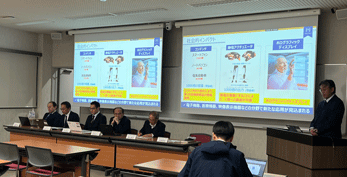2024.01.29
Development of a Ferroelectric Dimeric Liquid Crystal with Huge Spontaneous Polarization and Dielectric Constant at Low Temperatures
Contributing to improved performance of electronic devices
- Succeeded in developing a ferroelectric dimeric liquid crystal with huge spontaneous polarization (8 μCcm-2) and dielectric constant (8,000) at low temperatures (55℃ and higher)
- Achieved huge spontaneous polarization and dielectric constant by using three polar phases (nematic phase, smectic-A phase, and isotropic phase)
- Contributed to improved performance by applying dimer molecules to electronic devices such as capacitors, piezoelectric elements, electrostatic actuators, and 3D video display elements
At the Tokyo Tech LG Material & Life Solution Collaborative Research Cluster, a joint research team composed of Shigemasa Nakasugi (Joint Researcher with Industry and Other Organizations Including the Private Sector), Adj. Prof. Hiroki Ishizaki, Adj. Assoc. Prof. Sung Min Kang of LG Japan Lab, Prof. Masato Sone, Adj. Prof. Junji Watanabe and Assoc. Prof. Tso-Fu Mark Chang of the Laboratory for Future Interdisciplinary Research of Science and Technology, and Professor Takaaki Manaka of the School of Engineering, developed a ferroelectric dimeric liquid crystal with spontaneous polarization that exceeds (8 μCcm-2) and a dielectric constant that exceeds 8,000 at low temperatures.
Ferroelectric liquid crystal are a unique type of liquid crystal that have high spontaneous polarization and dielectric constant. Among these, dimeric molecules have a simple molecular structure and can form a ferroelectric phase at low temperatures, so they are expected to be a material with excellent applications. In this research, the joint researchers developed a dimeric molecule called di-5 (3FM-C4T), which has a fluorine-substituted mesogen core linked to side wings by a pentamethylene spacer. Researchers confirmed that this dimeric molecule exhibits liquid crystallinity at low temperatures (55℃ to 211℃), and is composed of three polar phases: nematic, smectic, and isotropic, with a huge spontaneous polarization (8 μCcm-2) and dielectric constant (8,000). The researchers succeeded in developing a dimeric liquid crystal that exhibits ferroelectricity at low temperatures. Using the dimeric molecules developed through this research will enable the creation of technology such as capacitors for smaller electronic devices and lower power consumption, piezoelectric elements and electrostatic actuators that can be driven at low voltages, and holographic displays that show three-dimensional videos. This development is expected to lead to new applications in fields such as automobiles, industrial robots, and medical equipment.
These research results were achieved by the Tokyo Tech LG Material & Life Solution Collaborative Research Cluster, which is a joint research organization of LG Japan Lab and Tokyo Institute of Technology. The results were published in The Journal of Physical Chemistry B(External site).
Specially Appointed Prof. Hiroki Ishizaki held a press conference to announce the press release(January 26, 2024)
LG Material & Life Solution Collaborative Reseach Clusters, Prof. Hiroki Ishizaki held a press conference at Tokyo Institute of Technology Ookayama Campus on Saturday, January 26, 2024 to announce the press release “Development of a Ferroelectric Dimeric Liquid Crystal with Huge Spontaneous Polarization and Dielectric Constant at Low Temperatures”. The press conference was held on Saturday, January 26, 2024, at the Ookayama Campus of the Tokyo Institute of Technology.
We received many questions from the press at the press conference.



